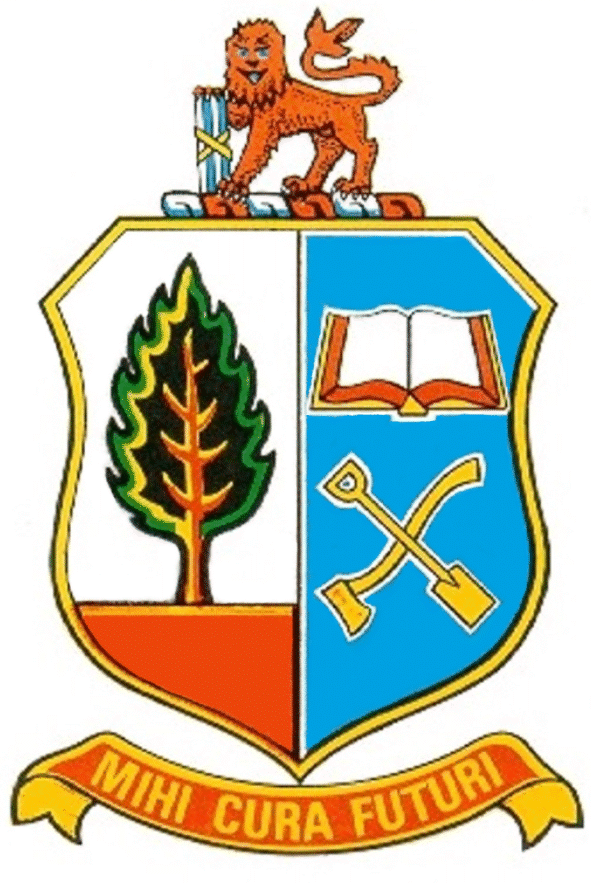

SAASVELD COLLEGE FOR FORESTERS / SAASVELD KOLLEGE VIR BOSBOUERS, Saasveld, George.

The arms were registered in 1971 under the Heraldry Act by the State Herald, Certificate 416. They are blazoned:
Arms: Per pale Argent and Azure: dexter, a tree on a ground proper,
sinister, an axe and spade in saltire, shafts upwards, Or, and above an open
book Argent, edged Gules, bound Or.
Crest: The South African Lion, i.e. the crest on the coat of arms of
the Republic of South Africa.
Wreath: Argent and Gules.
Motto: MIHI CURA FUTURI.
About the arms:
The ground is illustrated as being red-brown, rather than the usual green.
This underlines the fact that the college is focused on the plantation cultivation of exotic tree types, since in plantations the ground is bare – partly as a result of weed control, partly because the root systems of pine trees remove most of the surface soil moisture.
The tree is not specified as to type, but its growth habit is typical of trees of the genus Pinus (pine).
The axe and spade are typical forestry tools; they appear together with a book, emphasising the role of theory in the training of foresters.
Anomaly of the crest:
The awarding of the crest, which duplicates the crest in the arms of the Union and Republic of South Africa, is extraordinary in that in other instances permission has been refused for the use of the crest lion on the grounds that it is a national symbol.
This is in contrast with the frequent British usage of granting arms incorporating a single lion of England (gules, a lion passant gardant or), a St George cross (argent, a cross gules), a royal tressure (a double tressure flory counter-flory, usually red but occasionally in other colours), or a St Andrew’s cross (azure, a saltire argent) to signify a royal honour, where the person so honoured is usually not a member of the royal family, or where the insitution concerned has no direct connection with the national government (although all local authorities in Britain are regarded as being under royal authority).
An institution that was refused the use of the Union lion was the Genealogical Society of South Africa, a national organisation in civil society which in Britain would routinely be considered for such recognition.
Although the college was at the time under the control of the Department of Forestry, and so was a State institution, it can hardly be seen as an essential part of the central government apparatus deserving of the undifferenced usage of part of the emblemage of the country.
The lack of any mark of difference whatsoever makes the award of the crest even more extraordinary. The crest animal is not incorporated into the shield and bears no particular mark or change of colour; it is simply the national crest added to the device of an educational institution.
Original badge:
These arms replace an earlier emblem registered under the Protection of Names, Uniforms and Badges Act of 1935 (Certificate 23 of 1935). The official description of this badge (registered as part of a uniform incorporating a blazer of specified colour and stripes), includes mention of the background (which in heraldic terms is irrelevant). It reads:
On a bottle green background, a shield bordered gold with inner shield on a sky-blue background; the latter divided into three unequal sections containing representations of a crossed axe and spade, an open book and a tree, placed respectively in the bottom right, top right and left-hand sections; above and below the inner shield respectively a representation of a crown and a scroll bearing the letters S.A.F.S. and S.A.B.S. and the motto MIHI CURA FUTURI.
It can be noted that in this badge (the composition of which differs little from that of the arms illustrated above) the shield is ensigned of a crown, which represents the authority of the State; at that time a British Dominion of which King George V was the Head of State.
(The “left” and “right” in this description are left and right from the point of view of the person facing the badge; in contrast heraldic dexter and sinister are right and left as seen from the point of view of the wearer.)
It can be seen that the Union lion was inserted in place of the crown, and must have been regarded as a republican symbol.
About the college:
The college, previously the South African Forestry School and based at Tokai in the Cape Peninsula, was moved to the farm Saasveld, close to the town of George, in 1932.
The entry in the Standard Encyclopædia of Southern Africa notes that the college is “for in-service training of officials of the Forestry Department in the following subjects: silviculture, forest botany, the protection, expoloitation, utilisation and management of forests, forestry law, bookkeeping, building construction, nursery practice, forest mensuration, plane surveying, and administration”.
It continues: “The Department gives these courses to its own officials after a year’s practical training in a forest reserve. Saasveld is in this sense a purely departmental college, but also takes a few private students, including one or two from Rhodesia.” [1]
The word “forest” is used here exclusively in the meaning of plantation. Little or no attention was paid to indigenous forest, which was routinely regarded as being “bush”.
The college has since been freed from being so closely bound to the government service. It was for some years a school of the Port Elizabeth Technikon, which at the beginning of 2005 was merged into the Nelson Mandela Metropolitan University.
